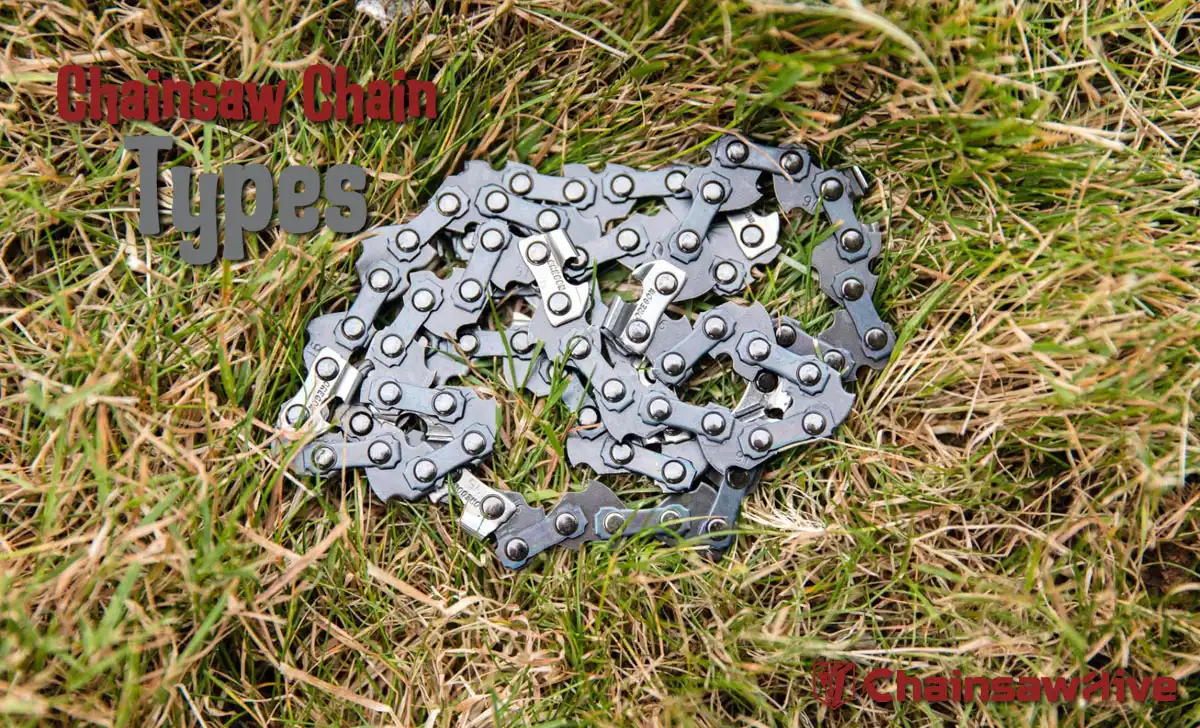When it comes to chainsaw chain types, it’s like choosing the perfect partner for a tango – the right match is essential. These chains are more than just metal links; they’re the heart and soul of your chainsaw’s performance. Think of them as different characters, each with a role to play in the grand play of woodworking.
Heard the expression, “You’re only as good as your tools”? All things considered, in the realm of chainsaws, this couldn’t be more genuine. Envision you’re out there, prepared to handle a monster oak, and all you have is a chainsaw with some unacceptable chain. It’s like bringing a butter knife to a sword fight!
The core of a chainsaw’s cutting ability lies in its chain. Be that as it may, not all chains are made equivalent. Each type has its own superpower, intended for explicit assignments, materials, and clients. In this article, we’ll cut through the intricacies of chainsaw chains. Consider it a matchmaking manual for track down your chainsaw’s ideal accomplice.
Let’s explore the five key types of chainsaw chains:
- Chain Pitch
- Chain Gauge
- Cutter Material
- Cutter Style
- Chain Arrangement
In light of these five sorts, you’re well on route to understanding the substance of chainsaw chains. We should get everything rolling and guarantee you never bring a margarine blade to a chainsaw battle!
The Difference in Chainsaw Chains
Imagine you’re venturing into the dense forest, chainsaw in hand, ready to tackle the toughest of trees. But wait! The secret weapon isn’t just the chainsaw; it’s the chain. That’s right, today we’re diving into the diverse world of chainsaw chain types. Each type boasts its unique features, transforming your chainsaw into a tool fit for any job, be it a delicate art project or robust lumberjacking.
Chain Type Matters
Chainsaw chains aren’t one-size-fits-all. They’re more like shoes; you need the right type for the occasion. Some are designed for rugged, professional use, while others are perfect for that occasional backyard trim. We’ll explore how choosing the right type can transform your chainsaw experience.
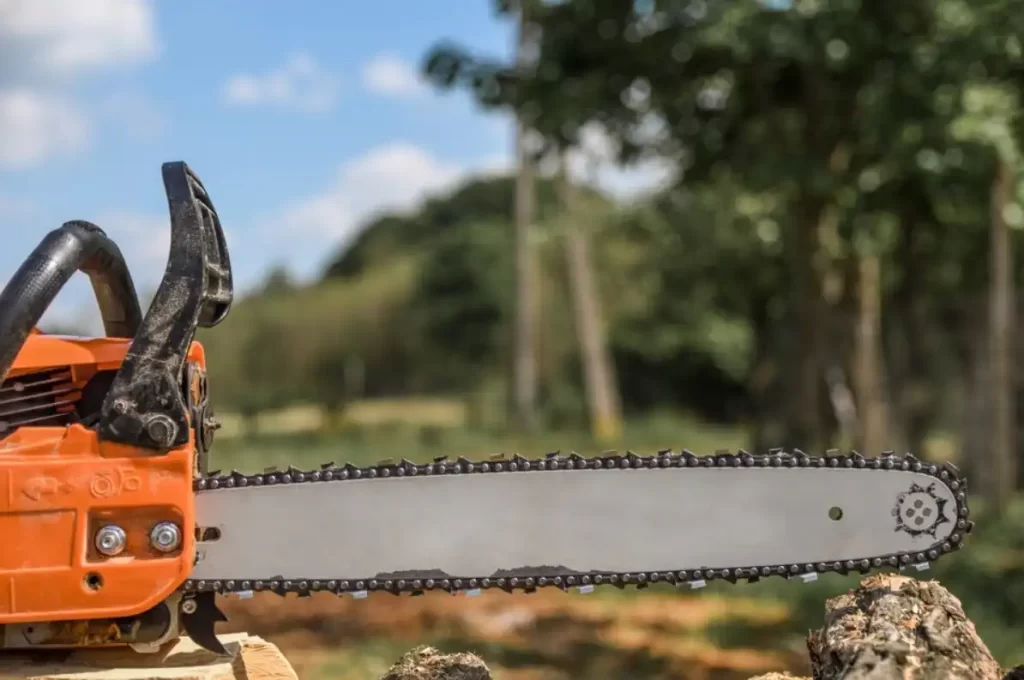
Cutting Speed and Efficiency
It’s not just about power; it’s about smart power. The right chain can maximize your chainsaw’s cutting speed and efficiency, turning a daunting task into a walk in the park. We’ll delve into how different chains interact with wood and how this affects their cutting prowess.
Gauge and Pitch Comparison
Gauge and pitch might sound like technical jargon, but they’re crucial in picking the right chain. They determine how well your chain fits and moves. A mismatch can mean a less effective, even dangerous cutting experience. We’re here to demystify these terms for you.
Material and Durability
A chain is only as good as its material. We’ll examine what chains are made of and how this affects their lifespan and sharpness. It’s about finding a balance between toughness and endurance.
Maintenance Considerations
A great chain demands respect and care. Proper maintenance can be the difference between a chain that lasts years and one that gives up mid-job. We’ll provide tips on keeping your chain in top shape, ensuring it’s always ready when you are.
Chain Teeth and Safety
Last but certainly not least, we’ll talk about teeth – chain teeth, that is. Their design not only affects how well they cut but also your safety. Understanding this can help prevent accidents and ensure a smooth, safe cutting experience.
Length of the Chainsaw Guide Bar
When it comes to chainsaws, it’s not just about the teeth that do the cutting; it’s also about the stage they dance on – the guide bar. The length of your chainsaw’s guide bar is a crucial factor that works hand-in-hand with your chainsaw chain types to determine the efficiency and safety of your cutting experience. Let’s explore how the guide bar plays a pivotal role in your chainsaw’s performance.
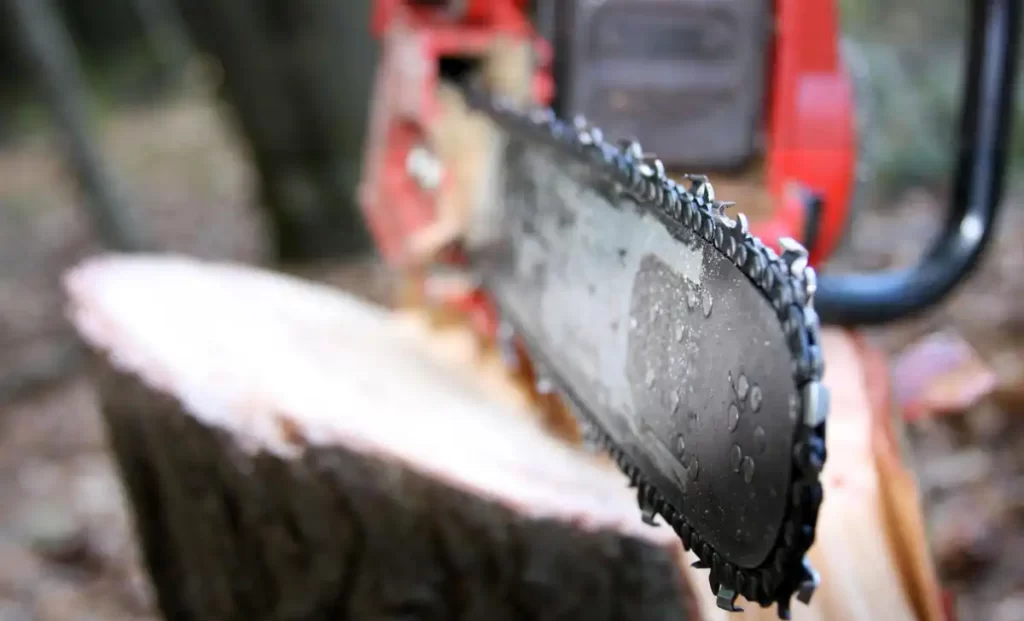
Guide Bar Length Overview
Think of the guide bar as the chainsaw’s arm. Its length can range from small and nimble to long and powerful. We’ll explore what these lengths mean and how they translate to different types of chainsaw work.
Cutting Capacity Impact
The length of the guide bar directly influences what you can cut. A longer bar can tackle bigger trees, but it’s not always better. We’ll delve into how to match the bar length to the task at hand for maximum efficiency.
Balance and Control
Handling a chainsaw is an art, and the length of the guide bar is a big part of that. A longer bar might give more reach, but it can also throw off the chainsaw’s balance. We’ll discuss how to find that sweet spot for control and precision.
Portability and Maneuverability
Longer isn’t always more practical. We’ll talk about how guide bar length affects the chainsaw’s portability and ease of use, especially in tight spaces or when working at awkward angles.
Safety and User Experience
Safety first! The length of your guide bar not only affects how well you can control your chainsaw but also your safety while using it. We’ll cover the dos and don’ts to ensure a safe cutting experience.
Choosing the Right Length
Finally, we’ll guide you through choosing the perfect guide bar length for your needs. Whether you’re trimming branches or felling giants, there’s a right length for every job.
The Different Type of Chainsaw Blades
In the world of woodcutting, your chainsaw is your trusted ally, and the blade is its beating heart. The variety in chainsaw chain types is as vast and diverse as the trees they cut. Understanding these differences is key to mastering the art of chainsawing. Here, we’ll slice through the complexity and explore the different types of chainsaw blades, ensuring you’re well-equipped for any task at hand.
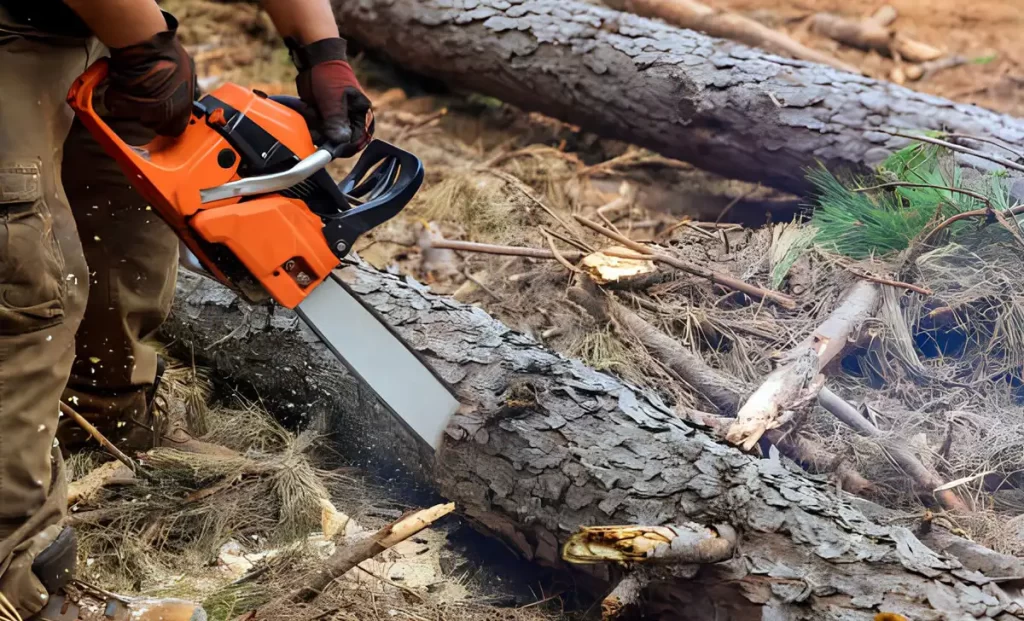
Chain Pitch
Chain pitch is like the heartbeat of your chainsaw blade. It’s the distance between the drive links and determines how the blade interacts with the wood. A smaller pitch means a finer cut, perfect for detailed work, while a larger pitch can handle tougher, larger jobs.
Chain Gauge
The chain gauge is the thickness of the drive links. It’s a small detail with a big impact on how the chain fits into the guide bar. A mismatch here can lead to poor performance or even damage.
Chain Gauge Table
| Inches | Millimeters |
|---|---|
| 0.043 | 1.1 |
| 0.050 | 1.3 |
| 0.058 | 1.5 |
| 0.063 | 1.6 |
Cutter Material
The material of the cutter dictates how long your blade stays sharp and how tough it can be against different types of wood. Common materials include steel alloys, with some featuring special coatings for extra durability.
Cutter Style
Cutter style affects how the blade interacts with the wood. There are full-chisel cutters for fast, aggressive cuts and semi-chisel for a more forgiving, durable option. The right style depends on your cutting needs and experience level.
Chain Arrangement
Chain arrangement refers to the sequence and spacing of the teeth on the chain. Some arrangements are designed for smooth, clean cuts, while others are geared towards speed and power. Understanding this can help you choose a chain that matches your cutting style and needs.
In this journey through the world of chainsaw blades, we’ve uncovered the nuances that make each type unique. Armed with this knowledge, you’re now better equipped to choose the right blade for your chainsaw, ensuring efficient, effective, and safe operation.
Guide to the Chainsaw Chain Types
When you’re in the market for a chainsaw, the term “one size fits all” doesn’t apply, especially regarding chainsaw chain types. Each type of chain has its unique characteristics, making it suitable for different tasks and materials. In this section, we’ll explore the various types of chainsaw chains, helping you to identify which type will best suit your needs, be it for professional lumberjacking or DIY backyard projects.
Full Chisel Chains: Features and Best Uses
Full Chisel Chains are the sprinters of the chainsaw world. With square-cornered teeth, they’re designed for fast, efficient cutting in hardwood. They’re perfect when time is of the essence, like in commercial logging. However, their aggressive nature makes them prone to kickback, and they dull quicker in dirty conditions.
Semi-Chisel Chains: Advantages and Suitable Applications
Semi-Chisel Chains are the marathon runners. Their rounded teeth are more tolerant to dirt and debris, making them a great choice for cutting softer woods or working in less-than-ideal conditions. They may not be as fast as full chisel chains, but their durability and reduced kickback risk make them a go-to for many users.
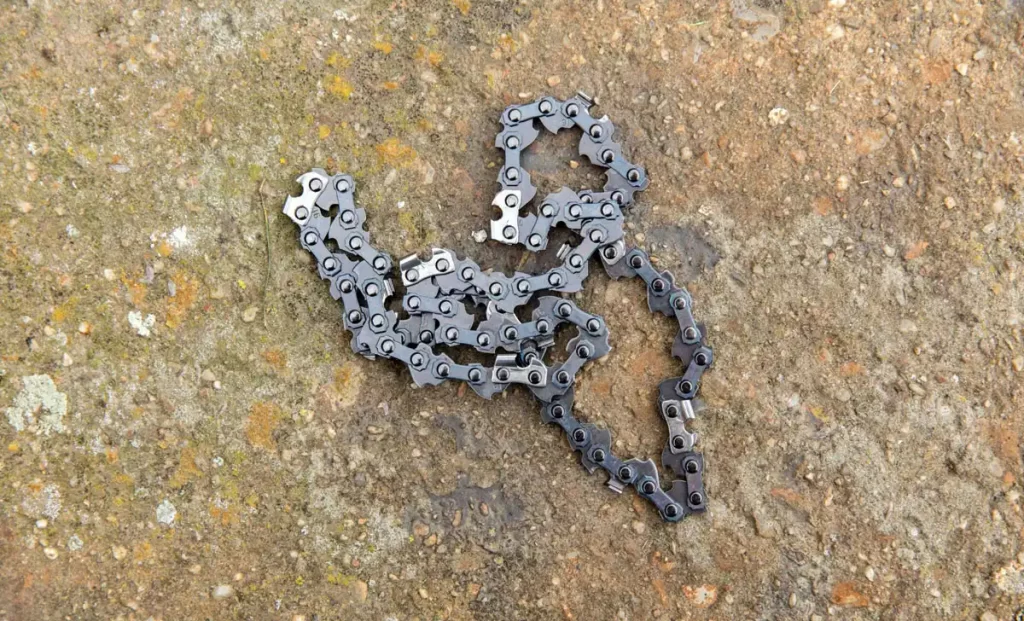
Low-Profile Chains: Characteristics and Safety Aspects
Low-Profile Chains are the friendly neighbors of the chainsaw world. Designed for lighter-duty work, they have a shorter profile and safety features to reduce kickback, making them ideal for casual or inexperienced users. They’re common on consumer saws and are great for tasks like pruning and light cutting.
Carbide-Tipped Chains: Durability and Specialized Uses
Carbide-Tipped Chains are the superheroes. With carbide tips on the teeth, they can withstand abrasive conditions like dirty wood or even cutting through ice. Their durability makes them perfect for challenging environments, but they do require special equipment for sharpening.
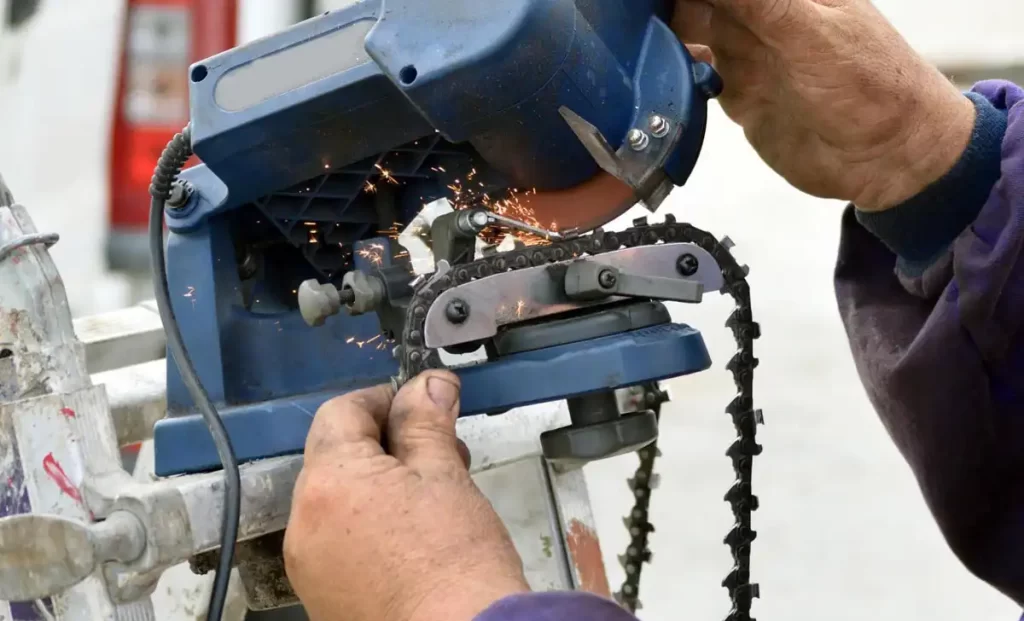
Ripping Chains: Specific Design and Applications
Ripping Chains are the artists. Specifically designed for cutting parallel to the wood grain, they’re used mainly in milling operations to produce lumber. With a unique tooth design and angle, they create smooth cuts and are essential for anyone looking to turn logs into planks.
Each of these chainsaw chain types has its stage where it shines the brightest. By understanding their features and best uses, you can make informed decisions, ensuring your chainsaw is not just a tool, but a trusted companion in your woodworking endeavors.
Selecting the Right Chainsaw Chain
Choosing the right chainsaw chain can feel like navigating a maze. With various chainsaw chain types available, each suited for different tasks, materials, and chainsaws, making the right choice is crucial for efficient and safe woodcutting. In this section, we’ll guide you through the essential factors to consider when selecting your chainsaw chain, ensuring you pick the perfect match for your needs.
Factors to Consider: Material, Size, Durability, and Compatibility
Choosing a chainsaw chain isn’t a one-size-fits-all affair. You need to consider the material of the chain, which affects durability, and the size, ensuring it fits your saw perfectly. Compatibility with your chainsaw is crucial, as an incompatible chain can lead to poor performance or even accidents. We’ll guide you through these considerations to ensure a perfect match.
Matching Chain Type to Cutting Tasks
Just like you wouldn’t use a butter knife to cut a steak, you wouldn’t use a low-profile chain for heavy-duty cutting. Matching the chain type to your cutting tasks is key. Full chisel chains for tough, large-scale jobs, semi-chisel for general use, and so on. We’ll help you understand which chain is best for your specific tasks.
Brand Considerations and Quality
Lastly, we can’t ignore the brand and quality. Not all chains are created equal, and a reputable brand can be a guarantee of quality and durability. We’ll dive into what makes a good brand and how investing in quality can save you time and money in the long run.
By the end of this section, you’ll be equipped with the knowledge to select a chainsaw chain that not only fits your saw but also enhances your cutting experience. Let’s dive in and find that perfect chain for you!
Maintenance and Safety Tips
Maintaining and safely using your chainsaw involves more than just handling it with care. The type of chain you use – yes, the various chainsaw chain types – plays a significant role in both the longevity of your chainsaw and your safety while using it. This section delves into essential maintenance and safety tips tailored to different chainsaw chains, ensuring both you and your tool stay in top condition.
Regular Maintenance for Optimal Performance
A well-maintained chainsaw chain is the key to efficient and safe cutting. Regular maintenance includes cleaning, sharpening, and adjusting the tension of the chain. We’ll show you how these simple steps can keep your chainsaw running smoothly and extend its lifespan.
Safety Precautions with Different Chain Types
Each type of chainsaw chain comes with its own set of safety considerations. For example, full chisel chains require more careful handling due to their aggressive cutting style, while low-profile chains offer more safety features for casual users. We’ll discuss the specific precautions you should take with each chain type to ensure your cutting experience is both efficient and safe.
When to Replace Your Chainsaw Chain
No matter how well you maintain it, every chainsaw chain has its lifespan. Knowing when to replace it is crucial for maintaining the performance and safety of your chainsaw. We’ll guide you through the signs of a worn-out chain and help you understand when it’s time for a replacement.
Learn more: How to Put a Chain on a Chainsaw
FAQs for Chainsaw Chain Types
What are the differences between full chisel and semi-chisel chains?
Full chisel chains have square-cornered teeth for fast cutting in clean conditions, ideal for hardwoods, while semi-chisel chains have rounded teeth, offering greater durability and performance in dirty or abrasive conditions.
How often should I maintain my chainsaw chain?
Your chainsaw chain should be maintained after every use, including cleaning and inspecting for wear, with sharpening as needed based on usage frequency and cutting conditions.
Can I use a carbide-tipped chain for regular woodcutting?
Yes, a carbide-tipped chain can be used for regular woodcutting; it offers enhanced durability but is generally overkill for standard conditions and more expensive.
What safety gear should I use with different chainsaw chains?
Always wear a hard hat, safety goggles, ear protection, gloves, and cut-resistant pants or chaps, regardless of the chain type, to protect against common chainsaw hazards.
How do I know when to replace my chainsaw chain?
Replace your chainsaw chain when you notice signs like consistent dullness despite sharpening, visible damage, difficulty in fitting, or a noticeable drop in cutting efficiency.
Conclusion
In wrapping up our chainsaw chain types, we’ve unearthed a wealth of knowledge critical for anyone wielding this powerful tool. From dissecting the nuances of different chain types – be it the robust full chisel chains or the resilient carbide-tipped ones – to understanding the significance of guide bar length, we’ve covered the essentials for making informed choices.
Key to our discussion has been the emphasis on matching the chain to the task at hand, underscoring the importance of considering factors like material, size, and durability. This isn’t just a matter of efficiency; it’s about harnessing the full potential of your chainsaw while ensuring safety and longevity.
Maintenance, as we’ve seen, is not an option but a necessity. Regular care, including cleaning, sharpening, and adjusting, is vital for peak performance. And with different chain types come different safety considerations, each demanding awareness and respect to prevent accidents.
As we conclude, remember that the power of a chainsaw is maximized when matched with the right chain and maintained with diligence. Whether you’re a professional logger or a weekend warrior, taking these insights to heart will ensure your chainsaw use is not just effective but also safe. Here’s to empowering your work with the right knowledge and tools – happy and safe chainsawing!
